Pros
Cons
Testing / Performance
The chart below shows a GretagMacBeth chart captured with the Pentax K100D that has been modified by Imatest to illustrate the color error. The big squares are the colors as the K100D shot them, the middle squares are the ideal colors, and the vertical rectangles show the ideal tones corrected for luminance.

The second chart shows the K100D's color gamut. The center of the gamut is completely unsaturated, or white, gray, and black. Color saturation increases toward the edges of the chart, and the colors are arranged around the center like a color wheel. Each point on the chart indicates a unique combination of hue and saturation. The small squares on the gamut chart show where the GretagMacbeth colors should be, and the large circles show how the K100D rendered them. The distance between the two indicates inaccuracy in general, but the arrangement shows saturation and hues errors distinctly – when the circle is farther away from the center than the square, the color is oversaturated. When the circle points away from the center, it indicates a hue error.
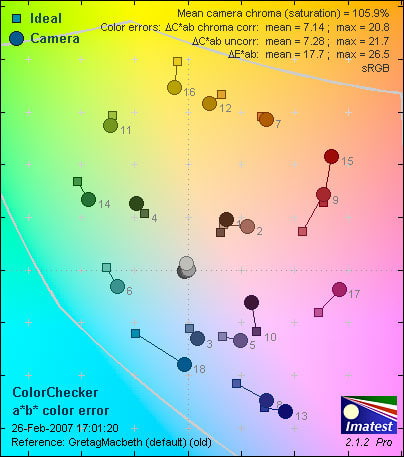
The Pentax K100D delivers a respectable mean color error of 7.28 but high saturation, at 105.9 percent. That's a good figure for compact snapshot cameras, a market segment that typically punches up color. Good scores for DSLRs targeted toward enthusiasts are within 3 percent of perfect. The K100D delivered its best results on our tests with exposure compensation set to -0.3 EV, so users may want to underexpose in real-world shooting. We shot at the K100D's lowest ISO setting, which is 200. **Still Life **We shoot our still-life scene with every camera we test, and post the full-resolution images to allow users to compare them. The fact that our procedure introduces scores of images of plastic sushi into the global data stream is just gravy, as far as we're concerned.
Click on any of the thumbnails below to view the full resolution images.
**
Resolution ***(5.66)*Resolution measures the amount of detail a camera can detect under ideal circumstances. We shoot our tests with cameras mounted on a heavy tripod and engage the self timer to prevent camera shake. In addition, we shoot at a variety of apertures and focal lengths, and report the best results. Again, we use Imatest software to measure resolution, based on images of a standard ISO resolution target. We report resolution in "line-widths per picture height," (lw/ph), a unit of measure that is directly comparable between all the types of cameras we test. Imatest also reports the amount of sharpening performed on an image.
[

](https://www.reviewed.com/cameras/viewer.php?picture=K100D-Res-lg.jpg)
Click to view high-resolution image
The Pentax K100D recorded 1253 lw/ph (horizontal), with 11.1 percent undersharpening and 1391 lw/ph (vertical), with 8.27 percent undersharpening. The lw/ph scores are poor, even considering the K100D's 6-megapixel image size. Even if the images were processed with image editing software to the ideal level of sharpness, the K100D would score poorly. The good news is that the K100D undersharpens, which is much easier to handle than oversharpening. Oversharpening can create halos and other artifacts that are practically impossible to remove from images. Our best test image was shot at f/10, with the lens set at 55mm. **Noise – Auto ISO (10.32)*Noise is the grainy texture that a camera adds to the image through technical flaws and the limitations of photo-electronic sensors and digital image processing. Though cameras can't eliminate noise completely, less noise is better, and digital cameras produce less noise at lower ISOs. We use Imatest software to measure noise. The ideal result for the Auto ISO noise test is for the camera to deliver the same results in Auto ISO as it does at its lowest manual ISO setting.
The Pentax K100D did exactly that – Auto ISO looked just like ISO 200, in our test. Of course, in real-world shooting situations, that wouldn't always be the case – in low light, the K100D's Auto setting would boost ISO, and noise would rise with it. In bright light, though, it works just as it should and its 10.32 Auto ISO Noise score reflects that. *Noise – Manual ISO ***(5.61)
*The chart below displays the K100D’s noise levels at its various manual ISO ratings. The horizontal axis shows the camera’s ISO settings, with the correlating noise plotted along the vertical axis. Again, these shots were captured in a controlled studio setting, using Tungsten illumination.

The Pentax K100D makes relatively noisy images at manual ISO settings--noise rises steadily from ISO 200 to 3200. The 3200 setting looks worse than grainy – it looks lumpy. Cheers to Pentax for giving users the option, but this 3200 should have been called an "extended range," or "High Mode." Oddly, the K100D's noise scores got higher when noise reduction was turned on for short exposures. The feature is meant for long exposures – 1 second or longer.
**Low Light ***(7.91)*We test low light performance at 60, 30, 15 and 5 lux. 60 lux is comfortable for reading, brighter than the typical living room. 5 lux is very dim, equivalent to the light cast by a single candle from about 1 ½ feet. We could not set a custom white balance with the Pentax K100D at 5 lux, so we used the tungsten preset. Though we tested the K100D both with noise reduction on and off, the score reflects its performance with noise reduction on.
The Pentax K100D scored well in our low light tests, with saturated colors even at our lowest tested light level. The K100D has a noise reduction algorithm, which kicks in on at exposures of 1 second or longer. The noise reduction system is slow – it takes roughly as long as the exposure itself. We also tested the K100D's noise levels at various exposure durations. In general, noise levels go up as the exposure is prolonged. In the chart below, the exposure time is plotted on the horizontal axis, while the corresponding noise is shown on the vertical axis.
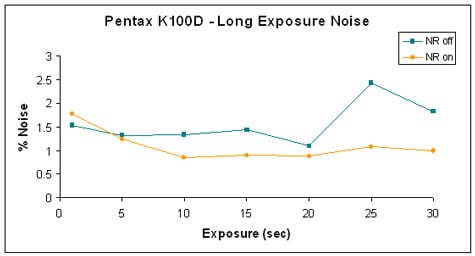
**Dynamic Range ***(8.52)*
Dynamic range refers to the span between the brightest and darkest values a camera can record with detail in a single image. We test dynamic range with Imatest software. We shoot images of a strip of film that shows a series of rectangles, running from nearly clear film to nearly opaque. The brightest rectangle is more than 14 EV brighter than the darkest, which is a wider range than any camera has recorded in our tests. Cameras' dynamic range performance deteriorates as ISOs increase, so we shoot at each full step in the ISO range. Imatest reports scores at a range of quality levels, which indicate how much noise is present at the extremes of the range. We report the "High Quality" result, which is limited to the range with 0.1 EV of noise or less.

The Pentax K100D recorded more than 7½ EV of dynamic range at ISO 200, and drops about ¾ of an EV at ISO 400 and 800. It dives by more than 1¼ EV from 800 to 1600, and drops another ¾ at 3200. These results are good for an entry-level DSLR, though they certainly indicate one of the advantages of shooting at low ISOs. **Speed/Timing***Startup to First Shot (9.0)*The Pentax K100D took 1 second from the moment we turned it on before its first shot. That's pretty quick for a consumer camera and quick enough for most users. *Shot-to-Shot (9.6)*The Pentax K100D's Continuous Shooting mode is slow for a DSLR. The K100D took five shots in a row at 0.4-second intervals. After 0.8 seconds, it took another shot, and then shot an image every 1.2 seconds. The K100D keeps up that pace until the card is filled. *Shutter-to-shot (9.0)*The K100D has the speed advantage that all DSLRs have over compact cameras: there is very little lag between the moment the shutter is pressed and the moment the exposure is made. With the lens pre-focused, the K100D delays less than 0.1 seconds. Even if the camera has to focus, it can shoot with a delay as short as 0.1 second.** ***Processing (8.0)
*The K100D took 5 seconds to clear its buffer after shooting a 5-frame burst, so it takes about 1 second to record each image to media. This is slow for a DSLR and a limiting factor for its burst mode. Shooting action, the K100D user might well be frustrated while waiting for the camera to get back up to speed.
Physical Tour
Front*(7.0)*The Pentax K100D's hand grip is rubber-covered with a diagonal ridge running down the front and a sensor for an infrared remote set flush about halfway down. The KA lens mount is spaced far enough from the grip to allow room for the user's fingers. The lens release button is at about 7 o'clock on the mount, and the autofocus switch is at 4 o'clock. The viewfinder hump juts forward over the lens, housing a pop-up flash, and featuring a Pentax logo on the front. There is a strip of resilient material along the right side of the front, adding more gripping surface for users who don't hold the camera by the lens. Some of Pentax's "pancake" lenses are so thin that there really isn't anywhere to grip them, so the second grip may be popular for users who own those lenses.

Back*(7.0)*The Pentax K100D's back is dominated by a 2.5-inch LCD display. The viewfinder is above it, with flash activation button to the left. The diopter adjustment is on top of the viewfinder. The buttons running down the left side of the LCD are, from top to bottom, Menu, Trash, Information and Playback. The K100's only control dial is to the right of the viewfinder, well to the left of the exposure/focus lock button, which is close to the right side. The 4-way controller is a set of five buttons – up, down, left, right and OK in the center. The K100D has a function button below the 4-way controller, and a status light is directly below it. The shake reduction switch is to the right of the function button. The Pentax K100D has a curved ridge along the right side of the back that acts as a thumb rest.
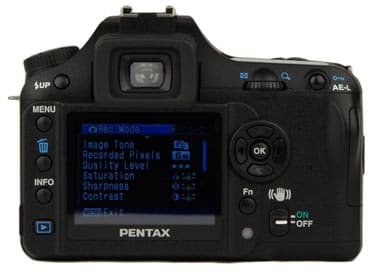
**Left Side***(6.0)*A stiff plastic door covers ports for a wired remote control, a USB/analog video port, and a DDC power input. There's a large, wide strap lug toward the top. The plastic door is less durable than the flexible rubber doors on competing cameras. Though breaking the door probably wouldn't incapacitate the Pentax K100D, it would leave the jacks completely unprotected, and would be an eyesore. The door does not offer much of a seal against dust and moisture, which could damage the USB and other jacks, and possibly lead to more damage deeper inside the camera.
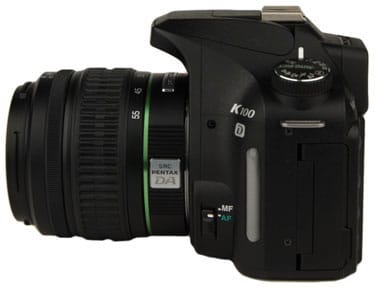
Right Side*(6.5)*Most of the right side of the Pentax K100D is plain and serves as a comfortable gripping surface. The SD memory card door takes up part of the side. Because SD cards are physically small, the door is small. The door slides back and swings out to expose the card slot. It's preferable for doors to have latches, which not only prevent them from opening accidentally but are usually more durable. The strap lug on the top of the right side is wide and sturdy, and it doesn't get in the way of a comfortable grip.

Top*(7.5)*The Pentax K100D's mode dial is on the left side of the top. The viewfinder hump is crested with a dedicated hot shoe. A large monochrome LCD covers much of the right side, providing readable and convenient shooting information. The shutter release is a large button at the summit of the grip. The power switch is a ring around it, with three positions – Off, On, and Depth-of-Field Preview.
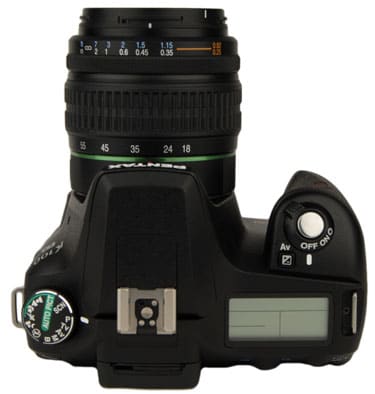
Bottom*(7.0)*Though the Pentax K100D's memory card door lacks a latch, the battery compartment door has one. The bottom is mostly plain. The tripod bushing is under the optical axis, which is convenient for aligning the camera on most tripods. Unfortunately, the smooth bottom will show scuffs and scrapes from tripod studs. Some competing cameras have a patch of protective material around the bushing, to hide wear. The Pentax K100D has small bumps at the margins of the bottom, to keep the camera off whatever surface it sits on.
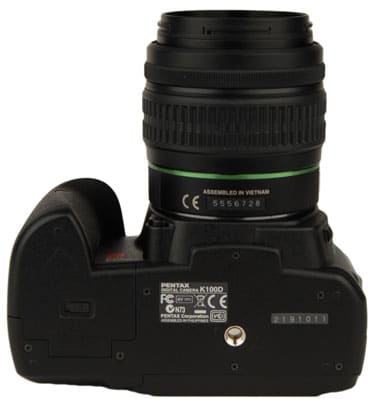
Components
Viewfinder*(7.0)*

Pentax claims 96 percent coverage and 0.85x magnification for the Pentax K100D's viewfinder. 96 percent coverage is typical or maybe a little better than average for DSLRs in general. Our sample camera was well-aligned – the viewfinder image was centered on the final image.
The Pentax K100D uses a penta-mirror optical system, which is less expensive than a penta-prism, but it is also less durable and generally less bright. The K100D's viewfinder is dimmer than other DSLRs, and with a relatively low magnification of 0.85x, its image is small. These two problems make the viewfinder hard to use. The viewfinder displays shutter speed, aperture, flash status, shake reduction status, focus information, picture mode, scene mode, ISO warning and autofocus mode in the viewfinder. Both the screen and the shooting data are easily visible, even for users who wear glasses. **

LCD Screen***(6.5)*The 2.5-inch, 210,000-pixel color LCD is sharp and bright, with pleasing color. The image solarizes moderately when viewed off-axis, but it remains visible over a wide angle of view. The monochrome display on top of the camera is large and easy to read. It displays Exposure Mode, Shutter Speed, Aperture, Flash Mode, Burst Mode, active Autofocus Site, Exposures Remaining and Battery status. The monochrome display is a definite plus – cameras that display comparable information on the rear LCD use much more power to do so. With a few exceptions rear LCDs are inconvenient to use because the light from the display is distracting when the user is looking through the viewfinder. **

Flash***(6.0)*The Pentax K100D's pop-up flash has a guide number of 15.4 at ISO 200, with distance measured in meters. That means it's effective to about 13 feet at f/ 3.5. The K100D's maximum flash sync speed is 1/180, which ought to allow some use of the pop-up as an outdoor fill flash, though not in bright sun. The K100D accepts Pentax dedicated flashes, which are capable of wireless operation. Unfortunately, the K100D does not act as a wireless controller – the user must have at least two dedicated flashes; one off the camera to light the subject, and another on the camera to control the off-camera unit. The K100D has flash exposure compensation, but the control is menu-based, so it's a pain to use. The K100D offers the following flash modes: On, Off, Auto, and red-eye reduction in auto or modes. **Lens and Mount ***(8.5)*The Pentax K100D's kit lens is an unimpressive 18-55mm, f/3.5-5.6 optic. Many users will be content with the lens, because it's cheap and covers a useful range of focal lengths. We didn't note much color fringing (halos of color at contrasting edges), but we noticed barrel distortion at the wide-angle setting.

The lens is not made as durably as the rest of the camera, and the maximum apertures aren't good enough for low light and are limiting even in moderate brightness. Pentax makes many very good lenses and has a long history of doing so. To get the best out of the K100D, users will need to upgrade to a better lens. Pentax has maintained the same bayonet mount for decades and provides options for users to mount old lenses to the K100D with various levels of functionality.
The K100D features Pentax's Shake Reduction system, which moves the sensor horizontally and vertically to compensate for camera movement. Pentax claims that the SR system allows the user to shoot at 2 to 3.5 EV longer shutter speeds. We don't yet have a quantitative test to evaluate those claims, but in casual use, we gained 2 EV of shutter speed, by our subjective judgment. The effect was most obvious at the 1/8 to 1/30 second range. It's important to note that the SR system measures camera movement, not image blur. That means that it estimates the amount of correction needed, rather than measuring it directly. The significance of this aspect is that the camera uses data about the focal length of the lens as well as the movement to calculate the amount of compensation needed. When older Pentax lenses are mounted, the user must manually enter focal length information via a menu to enable the Shake Reduction system. Given that many manufacturers have abandoned their legacy equipment, Pentax should be commended for offering the option to input the data.
Design / Layout
Model Design / Appearance*(7.0)*Pentax is careful about design, adding touches of color to their cameras and maintaining visual themes throughout camera lines. The ist DSLRs, which the K series cameras replace, have a science-fiction look to them, with sweeping contours that, in places, seem pure style – they don't accommodate camera parts or improve handling. The Pentax K100D and its stable mates have pulled back from that, with a more conventional, utilitarian design. The stylistic flourishes, such as the diagonal ridge on the grip, also improve the camera's function. The K100D, the K10D and the K110D look very similar, and they clearly share many components. This design consistency benefits the K100D, because it shares the higher-end K10D's sturdy body parts and excellent fit and finish. *Size / Portability***(8.25)*At 5.1 x 3.6 x 2.8 inches, the Pentax K100D is on the small end of DSLRs, though many price-competitive compact cameras are smaller. The size difference between the cameras does not affect portability – the slightly more petite Nikon D40x isn't easier to pack or carry. The difference may influence how comfortable the cameras are to use, however. The Nikon's grip cramps the lens mount, which may make the fatter Nikon lenses uncomfortable to use. The K100D shouldn't present that problem because it has more space between the grip and the lens mount, and Pentax lenses are generally compact.
Handling Ability*(7.75)*The Pentax K100D is comfortable to hold. The right hand's grip feels very good, with the diagonal ridge on its front a real benefit for comfort and security. The left side's grip surface will be helpful for users who buy Pentax's compact lenses. As noted above, the Pentax K100D is big enough for users with average-size hands to use comfortably.
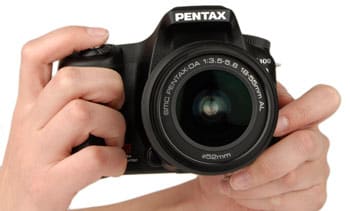
Control Button / Dial Positioning / Size*(7.0)*The Pentax K100D has only one control dial, so setting aperture and shutter speed in manual mode requires pressing a button and turning a dial. It's not as convenient as having two dials. On the other hand, the K100D's buttons, control dial, and mode dial are mechanically solid. They appear durable and are easy to use. The Shake Reduction switch is large – perhaps it's so big because the marketing department wants the feature to be prominently displayed. Still, it's easy to use, and the switch makes it easy to tell if the feature is turned on. **Menu***(7.0)*The K100D's menus are about as straightforward as the rest of the camera. The text is easy to read and most of the important stuff is higher on each list than more obscure items. There are an appropriate number of menu options for an entry-level DSLR.
A separate menu comes up in Playback mode.
The Fn (or Function) button brings up menus in both shooting and playback modes. A press of the button brings up a representation of the 4-way controller, with labels for each button. Here are the options in shooting mode:
Here are the options for the function menus in Playback mode:
Ease of Use*(8.0)*The Pentax K100D is laid out clearly and neatly. Both the physical interface – buttons, dials and displays – and the menu structure are logical and straightforward. Flash compensation is buried in the menus, which suggests the K100D isn't meant for serious flash shooters. The Function button adds an extra step to get to ISO, White Balance, Flash sync and Burst Mode. Those are very basic controls, and it would be better if they came up in a single action, rather than in two steps. The method Pentax chose makes the camera back simpler than some competing cameras: the Nikon D80 (actually, it's a step up from the K100D) has a couple of labels for each button because they have separate functions in shooting and playback modes. That might be more confusing than the K100D's setup. Pentax also provides an excellent, thorough, and well-written manual.
Modes
Auto Mode*(8.0)*The Pentax K100D's "Auto Pict" mode essentially turns the K100D into a point-and-shoot. The mode’s only weakness is that it can’t turn on autofocus if it's not already on. Other than that, it automatically adjusts ISO, white balance, shutter speed, and even pops up the flash when it's needed. If autofocus is on, it also chooses the focusing pattern and mode. **Custom Image Presets***(8.75)*Custom presets combine settings to approximate the way an experienced photographer would set the K100D to shoot a given type of photo. The K100D's algorithms do a reasonable job for each of the settings. The mode dial has six scene settings and eight more are accessible through a menu. A help function describes each mode very briefly. The information isn't enough to help users move from relying on scene modes to manual shooting, but it may help users choose between the modes.
**Drive / Burst Mode***(5.5)*The Pentax K100D has a burst mode, which cranks along at the rather slow clip of 2.5 frames per second for 5 shots. Competing cameras go a little faster – 3 fps is available – and shoot longer bursts. The short burst rate is likely to frustrate users. The K100D also has a self-timer and accepts remote control units. **Playback Mode***(7.5)*Users can choose to magnify images up to 12x, shows images full screen, or display nine thumbnails at a time. In full-frame mode, the K100D shows full exposure information and image parameters, or a histogram, or the image by itself. It includes a slide show function with intervals settable from 1 to 30 seconds. Playback mode also provides the interface for printing and access to the K100D's post-processing "filters." Read more about the K100D’s filters in the Picture Effects Mode section. **Movie Mode***(0.0)*The Pentax K100D has no movie mode. Current DSLRs are not designed to make movies.
Control Options
Manual Control OptionsThe Pentax K100D has a nearly complete range of manual controls. The user can set aperture, shutter speed, focus, ISO, white balance and parameters including saturation, sharpness and contrast. The controls aren't all convenient, but the only flat-out absence is a lack of white balance fine-tune. **Focus***Auto Focus (8.5)*The Pentax K100D's autofocus system is a particular strong point – or maybe 9 strong points. Pentax puts the same autofocus module in all its DSLRs. It consists of nine cross-type sensor sites, plus two conventional sites. Cross-type sites can sense focus in both horizontal and vertical detail. Of course, no sensor needs perfectly vertical or horizontal subject matter to focus, but typical sensors do better turned one way or the other with many subjects. Cross-type sensors find detail for focus in a wider array of subject textures than conventional ones. Two factors limit a camera's ability to focus: overall brightness of the scene, and contrast in the subject. Autofocus systems can't handle subjects with no contrast at all. A clear, blue sky is a good example. And in very low light, cameras get less and less accurate. We compared the Pentax K100D with the Nikon D2H and the Nikon D80, shooting scenes in a dimly-lit room, and shooting two targets we created in Adobe Illustrator. Aside from the fact that we had the two Nikons on hand, the reasons for choosing the D2H and the D80 are simple: the D2H was the first camera on the market with nine cross-type autofocus sensors, and it uses the same CAM-2000 autofocus module in the current D2X and D2Hs. The D80 uses a less-expensive 11-point module, with a single cross-type sensor in the middle of the frame. Our targets were rows of gray bars: dark gray bars on a black background, and pale gray bars on both a white and medium-gray background. This is not a standardized test. It was just an easy way to compare the cameras, with a clear idea of what they were focusing on. These tests do not measure focusing speed, which depends on lens mechanics. The Pentax K100D did much better than the D80, though not quite as well as the D2H. The K100D's nine cross-points are all a little better than the D80's only cross-point, handling lower light better with low-contrast targets. Testing the K100D's standard points with the D80's standard points gave the same result – the K100D came out on top. The D2H handled the test better than the K100D, and it has another advantage. Its sensor sites are spread more widely across the frame. *Manual Focus (6.0)*It's a good thing that the Pentax K100D's autofocus is so good because its manual focus is nothing to write home about. The screen is dim, and the image looks small because the viewfinder has only a 0.85x magnification ratio. The autofocus system could handle much lower light than the manual system. Manual focus is enabled by flipping the focus switch on the side of the lens mount. **Exposure ***(8.75)*
The Pentax K100D offers exposure compensation 2 EV above or below the meter reading, in 1/3-EV steps. That takes care of 90 percent of the compensation most users do, but some competing cameras offer up to 5 EV above or below. In manual mode, the K100D offers a clever option – pressing the auto-exposure lock button makes the aperture and shutter jump to the meter reading. It's an option that could speed up manual shooting in some situations.
**Metering ***(8.0)*
The Pentax K100D offers the standard three meter modes: Spot, Center-weighted Average and Evaluative. Spot metering measures a tiny area, about the size of an autofocus sensor site. Spot can be set so that it measures on the active AF site or just the center of the frame. Center-weighted takes a single reading, but it is more sensitive in the middle of the frame. It's a setting that some photographers like for landscapes. Evaluative metering takes several separate readings across the frame and uses a logic circuit to establish a proper reading. The Pentax K100D Evaluative system takes 16 readings, which is on the low end – some cameras sort through 256 measurements.
We found that the K100D's Evaluative system worked well in straightforward lighting situations – it's better than Center-weighted. Evaluative systems which are supposed to detect back-lighting and other high-contrast situations, and compensate for them. Like most other Evaluative systems, though, the K100D compromised too much in high-contrast settings, setting the camera to under- or overexpose the subject in order to maintain detail in the background. It got closer to the right exposure than Center-weighted, but in many situations, careful use of the Spot setting is the best choice.
White Balance*(7.0)*The Pentax K100D doesn't allow white balance fine-tuning, a useful feature for JPEG shooters (as opposed to RAW shooters), especially in mixed or fluorescent lighting. The K100D's options are comparable to many point-and-shoots. It offers an Auto setting, and presets for Daylight, Shade, Cloudy, Tungsten, Flash and three types of Fluorescent tubes. It also offers manual white balance, which saves a single white balance reading that the user can set by photographing a white target. The K100D adds the option of taking the manual balance from the whole image or just a small area at the center of the frame. White balance options are one of the K100D’s weak points.
ISO*(7.0)*The Pentax K100D's ISO range runs from 200 to 3200, plus Auto. ISO shifts in full-EV steps, which is less convenient and flexible than the 1/3-EV increments most DSLRs offer. The user can limit the Auto ISO range to 200—800 or 200—1600. The K100D can also show a warning when the ISO hits 400, 800, 1600 or 3200. Our image quality tests show that the K100D takes a big quality hit in every parameter at ISO 3200, it just may get a picture that no other option would.
Shutter Speed*(7.5)*With shutter speeds from 30 seconds to 1/4000, plus B for time exposures, the K100D's shutter doesn't impose any practical limit on shooting. The speed is set steplessly in Program and Aperture priority modes, and in 1/3-EV increments when set manually. Its maximum flash sync of 1/180 is a disappointment. Given its minimum ISO of 200, the sync speed limits outdoor fill flash to small apertures and very bright flashes.
Aperture*(0.0)*The Pentax K100D controls aperture electronically. The 18-55mm kit lens has a variable maximum aperture of f/3.5 to 5.6. That's very limiting for indoor, available-light photography. F/5.6 yields too much depth of field for portraiture. The minimum aperture we could get was f/38, which is too small for a lens of this focal length – diffraction will harm image quality at that setting. Pentax offers much better lenses, including two wider-aperture optics at about the same focal range. It might make sense to buy the K100D with a top-quality lens, rather than the K10D with a mediocre one.
Image Parameters
Picture Quality / Size Options*(8.5)*The Pentax K100D is a 6-megapixel camera. Its RAW files are 3008 x 2008 pixels, and it can record JPEGs at full resolution, 2400x1600 and 1536x1024 pixels. It offers three JPEG compression settings, indicated by 3, 2 or 1 star. 3-star images are suitable for printing, 2-star images are for on-screen uses, and 1-star images are small, but have only enough quality for emailing. The lower-quality JPEG settings save space, but for nearly every user, it makes sense to shoot high-quality, and compress the images later, if needed. The K100D's 2- and 1-star images show serious deterioration.
**Picture Effects ***(7.5)*The Pentax K100D offers effects in post-processing rather than during shooting. The effects are called "filters." The filters include Black and White, Sepia, Soften (which can be set to three different levels), Brightness, Slim, and Color. Slim distorts the image, either squeezing or stretching it up to twice its original size. It's an odd effect. In Pentax's manual, the example image of a shaggy dog looks peculiar. It would be very strange to use on people. Color tints the image one of nine colors, at two levels of intensity. The colors are: red, orange, yellow, yellow-green, green, cyan, blue, indigo, and purple. Aside from the dubious appeal of any of the filters except black and white, there is the significant drawback of trying to evaluate them on a camera's LCD display. If image quality is of importance, it would make much more sense to perform adjustments to the image on a computer with a reasonably large monitor. There's no way to predict how a print will turn out by looking at the image on the LCD.
Connectivity / Extras
Connectivity*Software (8.0)*The Pentax K100D is bundled with Pentax Photo Browser 3 and Pentax Photo Laboratory 3. Browser is a tool for downloading, organizing and printing images. Laboratory is a RAW file converter and image editing tool. Laboratory follows the design standards of the K100D and its manual: it's laid out logically and clearly, and it's easy to use. It can show out-of-gamut areas in each channel separately, allows direct editing of tone curves, and it has good options for adjusting white balance – that's nice, because the K100D doesn't have good white balance controls. In sum, it's not universal for manufacturers to bundle their best software with budget cameras, so the inclusion of the full-featured Laboratory is a strength of the K100D. *Jacks, Ports, Plugs (7.5)*The Pentax K100D has a USB/analog video port, a jack for a wired remote control, a jack for an external DC power source, a Pentax dedicated hot shoe, which also takes standard non-dedicated flashes, and an Infrared port for a wireless remote.
Direct Print Options (7.5)*The Pentax K100D is both PictBridge and DPOF compatible. PictBridge is a protocol for connecting cameras directly to compatible desktop printers, and DPOF is a protocol for creating digital print orders on camera memory cards, which can then be read by kiosk printers in camera shops, drug stores and so on. The K100D can be used to select the images to print, the number of prints to make, and whether to imprint the date on each. In PictBridge mode, the K100D can set size, paper type and print quality. There are more options available in each protocol, but the K100D offers basic printing. *Battery (4.5)*The Pentax K100D takes four AA batteries. NiMH rechargeable batteries will last longer than disposable batteries, and disposables will work in a pinch. The advantage is that they are cheap and available almost everywhere. Still, the better battery technology is Lithium-Ion. Lithium-Ion cells are customized for camera models and brands. They typically last longer than NiMH configurations, are more convenient, and are lighter. They are also more expensive, which may be why Pentax choose to go with AAs in the K100D.
*Memory (3.5)*The Pentax K100D accepts SD memory cards, the most popular memory format for digital cameras. Compact Flash cards are found in more DSLRs than SD cards, but SD cards are smaller, so they are prevalent in compact cameras and small DSLRs, like the K100D. We used cards up to 4 GB in the K100D, so it is capable of handling large-capacity memory.
*Other Features **(8.0)*Sensor Cleaning –* The Pentax K100D has a provision for manual cleaning, bending to the reality that dust gets inside interchangeable-lens cameras. If the batteries get weak during cleaning, the K100D issues warning beeps to indicate that it's about to shut down. *1-Button AE –* In full manual exposure mode, hitting the AE-Lock button sets the exposure to the metered value instantly. The feature makes manual shooting more convenient, especially on a camera with only one control dial. *Legacy Lens Compatibility –* The Pentax K100D will shoot pictures with old Pentax lenses, and Pentax medium format lenses, with an adapter. All of the K100D’s features aren’t with all of them, but they do mount and shoot. *ISO Limit & Warning – *The K100D can be set to limit its ISO range or can simply warn the user when the ISO goes over a certain level. Both options are useful.
Overall Impressions
**
****Comparisons***[

Nikon D40](https://www.reviewed.com/cameras/content/Nikon-D40-Digital-Camera-Review.htm) - The 6-megapixel Nikon D40 was introduced for $600, but Nikon quickly added the 10-megapixel D40x, which sells as a kit for just over $1,000. Both D40s have rudimentary 3-site autofocus systems and accept only a subset of recent Nikon lenses. At $550, the Pentax K100D has far better autofocus. The K100D is compatible with more lenses and comes with better software, especially RAW conversion software. The K100D has better color accuracy than the D40 as well. In general, the D40 lacks many of the advantages of the more expensive Nikons, while the K100D shares many of the features of Pentax's top-end K10D. * ***
[

Olympus Evolt E-330](https://www.reviewed.com/cameras/content/Olympus-EVOLT-E330-Digital-Camera-Review.htm) - *The Evolt E-330 is available online for under $550 with a lens, making it price-competitive with the Pentax K100D. The E-330's unusual feature is its live-preview LCD, which can function as an especially good manual focusing screen. Its autofocus system is primitive by comparison, and inferior to the K100D's AF. The E-330 is an 8-megapixel camera, and like many Olympus cameras, it is built to be durable – though the K100D seems equally tough. The K100D's interface is far more sensible. Olympus should study Pentax menus and try to clean up its messy DSLR menus.
*[

Sony Alpha A100](https://www.reviewed.com/cameras/content/Sony-alpha-DSLR-A100-Digital-Camera-Review.htm) - For $700, or about $150 more than the K100D, Sony offers the 10.2-megapixel Alpha A100, which has both image stabilization and dust control. The Sony's metering system is more accurate than the Pentax K100D's, but the K100D body has better ergonomics and is more durable. Both the A100 and the K100D are essentially snapshot cameras, with plenty of scene modes, and much less convenient manual controls. Assuming the users are snap shooters, the megapixel difference won't matter – the average user doesn't need the K100D's 6 megapixels, let alone the A100's 10.2 *
**
Value***(7.5)*The Pentax K100D is a good value. It's easy to use, well-built, and inherits some particularly worthwhile features from cameras at the top of its line. The autofocus system lives up to its specs, and is excellent. It also offers Shake Reduction. Though 6-megapixel cameras are becoming rare in both the DSLR and compact camera markets, there is a place for them. The file size is plenty big for most prints and they take up much less space on hard drives than 10-MP files, making them less taxing on slow computers. The K100D is less capable and sophisticated than the Pentax K10D, but Pentax made good choices as it simplified and economized. **Who It’s For***Point-and-Shooters - If a point-and-shooter really wants a DSLR, the Pentax K100D is a good choice. It's bulkier and more expensive than a compact snapshot camera, but it can be just as easy to use.
*Budget Consumers - *The Pentax K100D is a good value for photographers who need a DSLR, but not the complexity or high pixel count of the step-up cameras. The K100D is very competitive in its price range.*
***Gadget Freaks - The Pentax K100D lacks unique technology and therefore probably won’t appeal to this group. *Manual Control Freaks - *The Pentax K100D's manual controls are not convenient enough for photographers who habitually shoot manual. A second control dial would make all the difference. Pros/Serious Amateurs -* The Pentax K100D might make a good second body for photographers who don't need high resolution and whose main camera is the K10D – of course, that assumes that the K10D is a worthwhile main camera.* *
Conclusion
**Conclusion
**The Pentax K100D is just what an entry-level DSLR should be – simple to use and functional enough to take good pictures. Pentax deserves praise for putting such a good autofocus system in an inexpensive camera. The combination of the autofocus system and Shake Reduction system will increase the percentage of sharp shots for many users. The 3-zone autofocus systems in the Nikon D40 and Olympus's DSLRs look pathetic in comparison, and their performance bears out that impression. The K100D does have its flaws – its resolution performance is poor, and its white balance system is limited – but aren't likely to be a problem for the typical user.
Sample Photos
Specs / Ratings
Specs Table
{{manufacturer_specs_table}}{{raw_scores_table}}
Photo Gallery
Meet the tester

Patrick Singleton
Editor
Patrick Singleton is a valued contributor to the Reviewed.com family of sites.
Checking our work.
Our team is here to help you buy the best stuff and love what you own. Our writers, editors, and experts obsess over the products we cover to make sure you're confident and satisfied. Have a different opinion about something we recommend? Email us and we'll compare notes.
Shoot us an email